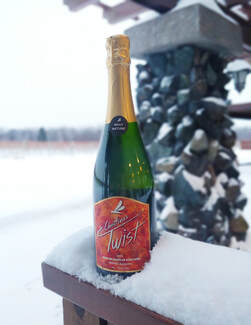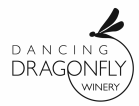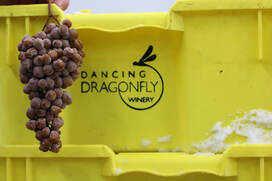
What better way to ring in the new year than by popping open a bottle of bubbly! At Dancing Dragonfly we like to celebrate with our sparkling wine, Christine’s Twist. This sparkling wine is made using Méthode Champenoise - the traditional method of producing champagne. What sets this apart from other processes of making sparkling wine, is that the wine goes through a secondary fermentation in the bottle.
When using the Méthode Champenoise process, we start by making a still wine (similar to a typical table wine) and add a carefully calculated amount of additional sugar and yeast to the bottle of wine. This step is called ‘tirage’ and initiates the second fermentation.
Tirage will add the effervescence to the wine. This step is often compared to bread baking. When making the bread dough, yeast is added to help it rise. The expansion of dough is due to the release of carbon dioxide when the yeast consumes the sugars in the mixture. A similar reaction happens during tirage with Christine’s Twist. The sugar is consumed by the yeast releasing carbon dioxide which gives the wine its bubbles.
The bottles are then stored on their sides for 18 months, or longer, to allow aging on the dead yeast cells, known as ‘lees’. Letting the wine age on the lees imparts the nutty, caramel and toast notes that are prominent in our sparkling wine. After the wine has had time to age, we need to remove the lees from the bottle.
The bottles are placed in a special rack that allows them to slowly shake and rotate from their side, to an upside-down position. This process, called ‘riddling’, allows the lees to settle in the neck of the bottle. The necks of the bottles are then frozen. The ice in the neck now contains the lees and is removed by a process called ‘disgorgement’. Due to the nature of disgorgement, a small amount of wine is lost and needs to be replaced before the bottle is corked. This is also the time when the sweetness level is adjusted. This allows the winemaker to make multiple styles of sparkling wine from the same tirage. These additions are called the ‘dosage’ and the volume of dosage is what dictates the style of the finished sparkling wine. The most common is Brut, but other common styles include Brut Nature, Extra Brut, Dry, Extra Dry, and Demi-Sec. Each of the style names equates to a level of sweetness in the wine. Think of it as you would dry, off-dry, and semi-sweet in table wines.
Once the wine is finally complete it is ready for its cork and cage. Keeping in tradition, the wine bottle is corked using a mushroom style cork, and the cage is added with six half-turns to secure the cork in place. The final pressure inside a bottle of Christine’s Twist is over 80 psi. This is the same pressure as a double decker bus tire! To put in perspective, a traditional bottle of beer is 20-35 psi.
This year, we have Christine’s Twist available in Brut Nature, Brut, and Demi-Sec.
The label design for Christine’s Twist uses a piece of work by artist Anne Labovits based in St. Paul, MN. To learn more about Anne Labovits, visit her website at http://labovitz.com/.
When using the Méthode Champenoise process, we start by making a still wine (similar to a typical table wine) and add a carefully calculated amount of additional sugar and yeast to the bottle of wine. This step is called ‘tirage’ and initiates the second fermentation.
Tirage will add the effervescence to the wine. This step is often compared to bread baking. When making the bread dough, yeast is added to help it rise. The expansion of dough is due to the release of carbon dioxide when the yeast consumes the sugars in the mixture. A similar reaction happens during tirage with Christine’s Twist. The sugar is consumed by the yeast releasing carbon dioxide which gives the wine its bubbles.
The bottles are then stored on their sides for 18 months, or longer, to allow aging on the dead yeast cells, known as ‘lees’. Letting the wine age on the lees imparts the nutty, caramel and toast notes that are prominent in our sparkling wine. After the wine has had time to age, we need to remove the lees from the bottle.
The bottles are placed in a special rack that allows them to slowly shake and rotate from their side, to an upside-down position. This process, called ‘riddling’, allows the lees to settle in the neck of the bottle. The necks of the bottles are then frozen. The ice in the neck now contains the lees and is removed by a process called ‘disgorgement’. Due to the nature of disgorgement, a small amount of wine is lost and needs to be replaced before the bottle is corked. This is also the time when the sweetness level is adjusted. This allows the winemaker to make multiple styles of sparkling wine from the same tirage. These additions are called the ‘dosage’ and the volume of dosage is what dictates the style of the finished sparkling wine. The most common is Brut, but other common styles include Brut Nature, Extra Brut, Dry, Extra Dry, and Demi-Sec. Each of the style names equates to a level of sweetness in the wine. Think of it as you would dry, off-dry, and semi-sweet in table wines.
Once the wine is finally complete it is ready for its cork and cage. Keeping in tradition, the wine bottle is corked using a mushroom style cork, and the cage is added with six half-turns to secure the cork in place. The final pressure inside a bottle of Christine’s Twist is over 80 psi. This is the same pressure as a double decker bus tire! To put in perspective, a traditional bottle of beer is 20-35 psi.
This year, we have Christine’s Twist available in Brut Nature, Brut, and Demi-Sec.
The label design for Christine’s Twist uses a piece of work by artist Anne Labovits based in St. Paul, MN. To learn more about Anne Labovits, visit her website at http://labovitz.com/.


 RSS Feed
RSS Feed
